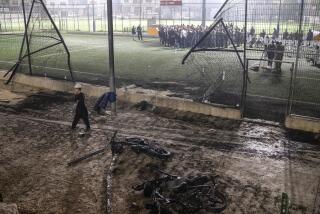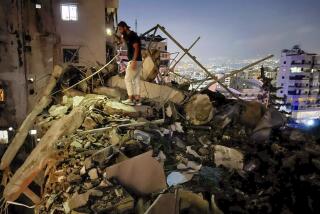Pentagon says human errors led to mistaken bombing of Syrian-backed forces
Washington — A U.S. military investigation has found that “unintentional human errors” led to a coalition airstrike that mistakenly killed dozens of Syrian-backed troops this fall, but it did not recommend disciplining anyone for the deadly attack.
The Sept. 17 air raid on a garrison in the eastern Syrian town of Dair Alzour is one of the worst coalition errors to emerge since the Obama administration began an air war against Islamic State militants in Iraq and Syria in mid-2014.
The attack, which was in an area also frequented by Russian forces, led to sharp criticism from Moscow after it emerged that Russian attempts to use a communications hotline to stop the attack were not answered for nearly half an hour.
Russia’s defense ministry has said the attack killed 62 Syrian troops, wounded 100 more and opened the way for an Islamic State offensive in the area. It also helped destroy an already fragile U.S.-Russian cease-fire.
A four-page redacted summary of the investigation that was released Tuesday concluded that the botched bombing did not violate international laws of armed conflict.
Warplanes from the United States, Australia, Denmark and Britain bombed and strafed what the pilots thought was a concentration of Islamic State fighters for nearly an hour.
Air Force Brig. Gen. Richard Coe, the lead investigating officer, told reporters at the Pentagon that the ground forces “looked and acted like” militants, but were probably Syrian government troops or militias aligned with President Bashar Assad.
The ground forces were not wearing formal military uniforms, flags or other indicators that would clearly establish their identity, Coe said.
“We concluded based upon post-strike analysis that a number of human factors resulted in incorrect identification of forces on the ground,” Coe said.
U.S. investigators said at least 15 people were killed, but Coe acknowledged that estimate may be low. He said U.S. investigators did not have access to the site and could not be certain of the total.
The error began after U.S. reconnaissance drones began tracking a vehicle believed to belong to an Islamic State militant. The vehicle drove through militant-held territory in eastern Syria before arriving at the garrison in Dair Alzour.
The early assessment “colored” later analysis and resulted in “invalid assumptions” that led to faulty identification of the ground forces, Coe said.
One analyst had concluded that the ground forces, based on their behavior and equipment, were not likely to be Islamic State fighters. But that dissent did not reach commanders who authorized the airstrike.
U.S. analysts watched the site for two days, and the target underwent what the military calls a thorough assessment, review and validation process, Coe said.
U.S. and coalition commanders at the air operation center in Qatar decided it was an Islamic State target and ordered an attack with F-16s, F/A-18s, A-10s and armed drones.
Because the area was frequented by Russian and Syrian forces, the U.S. military used an emergency communications line to warn Russian authorities in Syria of the pending attack. It was the first time such a warning had been given, Coe said.
But the U.S. officials provided ground coordinates more than two miles from the target, investigators found.
After the bombing began, the Russians tried to use the hotline to warn the U.S. commanders they were killing Syrian forces by mistake.
But the U.S. official authorized to speak on the calls was not available, Coe said. So the Russians hung up and called back until they finally reached the U.S. official 27 minutes later.
“In this instance, we did not rise to the high standard we hold ourselves to, and we must do better than this each and every time,” Lt. Gen. Jeff Harrigian, commander of U.S. air forces in the Middle East, said in a statement.
U.S. investigators said “unintentional human errors” occurred. They recommended improvements to the hotline system to ensure critical information is given more quickly to available personnel.
The Obama administration opposes Assad’s continued rule but the U.S. military does not deliberately target Syrian troops. Russia entered the war last year to support Assad in the country’s complex civil war.
»
»
Twitter: @wjhenn
ALSO:
Climate change is real: Just ask the Pentagon
Overweight, tattooed, stoned? The Pentagon may still want you
More to Read
Sign up for Essential California
The most important California stories and recommendations in your inbox every morning.
You may occasionally receive promotional content from the Los Angeles Times.










